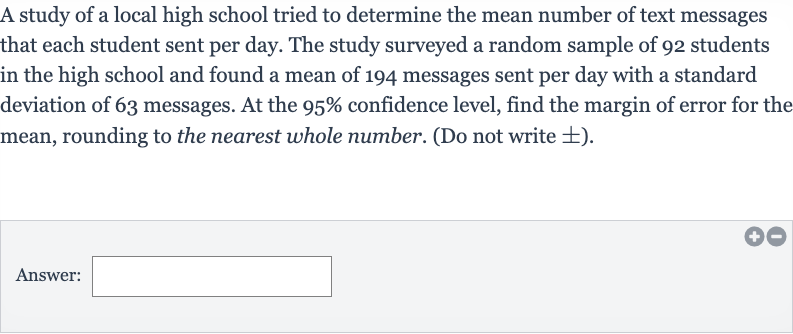AI tutor
Welcome to Bytelearn!
Let’s check out your problem:

A study of a local high school tried to determine the mean number of text messages that each student sent per day. The study surveyed a random sample of students in the high school and found a mean of messages sent per day with a standard deviation of messages. At the confidence level, find the margin of error for the mean, rounding to the nearest whole number. (Do not write ).Answer:
Full solution
Q. A study of a local high school tried to determine the mean number of text messages that each student sent per day. The study surveyed a random sample of students in the high school and found a mean of messages sent per day with a standard deviation of messages. At the confidence level, find the margin of error for the mean, rounding to the nearest whole number. (Do not write ).Answer:
- Identify Formula: To find the margin of error at the confidence level, we need to use the formula for the margin of error (ME) in a sample mean, which is , where is the z-score corresponding to the confidence level, is the standard deviation, and is the sample size.
- Find Z-Score: First, we need to find the z-score that corresponds to the confidence level. For a confidence interval, the z-score is typically because it captures the central of the normal distribution.
- Calculate Margin of Error: Next, we will plug in the values for the standard deviation ( messages) and the sample size ( students) into the margin of error formula.
- Plug in Values: Now, we calculate the margin of error using the formula .
- Calculate Square Root: We calculate the square root of the sample size, , which is approximately .
- Divide Standard Deviation: Now, we divide the standard deviation by the square root of the sample size: .
- Multiply Z-Score: Finally, we multiply the z-score by this result to find the margin of error: .
- Round to Nearest Whole: Since we need to round to the nearest whole number, the margin of error is approximately messages.
More problems from Interpret confidence intervals for population means
QuestionGet tutor help
QuestionGet tutor help
QuestionGet tutor help
QuestionGet tutor help
QuestionGet tutor help
QuestionGet tutor help
QuestionGet tutor help
